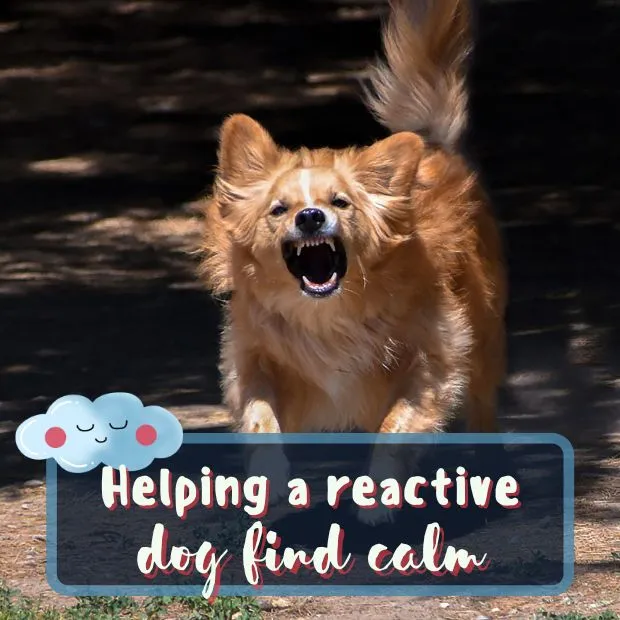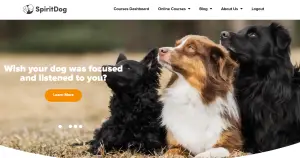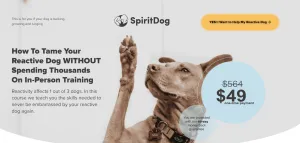Imagine the life of a reactive dog. These dogs are always on high alert, constantly scanning their environment for potential threats. When something sets them off, they can become difficult to handle.
Thankfully, there are ways of helping a reactive dog find calm and stability. By teaching them how to relax and focusing on positive reinforcement, we can help these dogs learn how to live more peacefully in our society.
Read on for 9 tips on helping your reactive dog find calm.
Table of Contents
ToggleContents of this article:
- Understanding their body language.
- Using the right equipment.
- Changing your routine.
- Taking a cortisol holiday.
- Chewing, licking and foraging.
- Supplements.
- Counter conditioning and desensitization to triggers.
- Incompatible behaviors.
- Seeking professional help.
- Last words on helping a reactive dog find calm.
Helping your fear reactive dog find calm through understanding their body language.
Dogs are remarkably expressive creatures, conveying a wide range of emotions through their body language. However, interpreting a dog’s body language can be difficult, particularly for those who are new to dog ownership.
For example, many people mistakenly interpret a wagging tail as a sign of happiness, when in reality it can indicate excitement, fear or even aggression. Recognizing the subtle cues in a dog’s body language is essential for creating a harmonious relationship.
If you have a reactive dog, it is especially important to understand their body language. Reactive dogs are often quick to startle and can become agitated easily.
Watch out for signs of stress, such as a stiff body, rapid breathing, tension in their tail, looking away from triggers, and out of context behaviors such as lip licking, yawning, scratching themselves and self-grooming.
If you see these signs, try to help your dog relax by increasing distance between them and their triggers or doing some scatter feeding.
By learning to recognize these signs and read reactive dog body language, you can help your reactive dog to find calm and prevent outbursts of aggression. Here’s a great book on canine body language by Lili Chin.
How to help a reactive dog find calm through the right equipment.
Dogs are prone to experiencing a wide range of emotions, from excitement and happiness to fear and anxiety. This emotional volatility can make it difficult for owners to provide the stability that their dogs need.
However, the right equipment can help to create a calm environment for dogs, even in the midst of chaos. Dog crates, for example, provide a secure space for dogs to retreat to when they feel overwhelmed. Similarly, dog beds can help to create a sense of comfort and safety.
Walking equipment is especially important for a reactive dog, to keep everyone safe. Invest in a well fitting Y-shaped harness so that your dog does not injure themselves lunging at the end of the leash. Be sure to use a 6 foot leash, as shorter leashes can increase reactivity if a dog feels too closely restrained.
I use a walking belt with my reactive client dogs to help manage them on walks. The belt is a reliable connection between me and the dog, and it means I am more grounded and stable if a reactive dog lunges.
This gives me greater confidence in managing my client dogs around triggers. I highly recommend this type of equipment, as this has been an invaluable tool in managing my client dogs on walks.
You may also want to consider using a muzzle when walking your reactive dog in public, to prevent them from biting out of fear or aggression.
By investing in the right equipment, owners can help their dogs find the calm they need to thrive.
Help your dog find calm through changing your routine.
Most dog owners are keenly aware of the fact that their furry companions thrive on routine. A set feeding schedule, regular walks, and consistent rules helps dogs to feel safe and secure.
One of the easiest things you can do is to adjust your routine to take your dog’s reactivity into account. Taking your dog for a walk during times which are less busy, so you will encounter fewer triggers, can make life less stressful for both you and your dog.
Avoid places where you have less control over keeping your dog’s triggers at a distance. For example, if your dog is triggered by other dogs being too close to them, avoid places where an off-leash dog may have an opportunity to run up to them.
Changing your routine to avoid triggers can help to keep them calm and relaxed.
Help your dog find calm through a cortisol holiday.
Have you ever noticed that your dog seems to be constantly on edge? If so, it might be time for a cortisol holiday. Cortisol is a stress hormone that plays an important role in the body’s fight-or-flight response.
However, when levels of cortisol are constantly elevated, it can lead to health problems such as weight gain, anxiety, and gastrointestinal problems. Cortisol can take 72 hours to leave the body so your dog never has the opportunity for the cortisol to dissipate if it is being topped up every time they go for a walk.
A cortisol holiday is a period of time during which your dog can relax and de-stress, where you avoid all triggers and engage in lots of calming activities.
This means not taking your dog for a walk for 72 hours. During this time, you can focus on giving your dog lots of affection, engaging in calm play, and providing them with food puzzles to keep their minds occupied.
A cortisol holiday can be a great way to help your reactive dog find calm and relaxation.
Help your dog find calm through chewing, licking and foraging.
Chewing, licking and foraging are all activities that help to calm the nervous system.
Chewing and licking releases endorphins, which have pain relieving and calming effects. Foraging for food is another activity that can help to calm the nervous system, as it helps to occupy your reactive dog’s nose and mind, providing a sense of satisfaction.
There are many different ways that you can help your dog to chew, lick and forage. You can give them Kongs stuffed with food, offer them puzzle toys filled with treats, give them Lickimats, or hide food around the house for them to find.
Help your dog find calm through supplements.
There are many supplements manufactured specifically for dogs that can help to calm the nervous system.
These supplements usually contain ingredients such as chamomile, valerian root, and L-theanine. Chamomile is a herb that has calming effects, while valerian root is a sedative. L-theanine is an amino acid found in green tea that helps to reduce anxiety.
There are many different supplements available on the market, so it is important to speak to your veterinarian before giving your dog any. They will be able to advise you on whether or not a particular supplement is suitable for your dog and what the correct dosage is.
Help your dog find calm through counter conditioning and desensitization to triggers.
Counter conditioning is a process that involves changing your dog’s emotional response to a trigger. For example, if your dog is scared of loud noises, you can gradually expose them to loud noises at a level which is not scary for them.
Each time they hear the noise, you will provide them with a positive experience such as treats or a toy. Over time, your dog will begin to associate the trigger with something positive and their fear will lessen.
Desensitization is a similar process, but rather than gradually increasing the level of the trigger, you instead keep it at a level which does not scare your dog.
For example, if your dog is scared of other dogs, you would expose them to other dogs at a distance which does not scare them. With repeated controlled exposures over time, your dog will become less and less scared of the trigger.
These two processes are usually combined to create a comprehensive treatment plan for dogs with anxiety.
Counter conditioning and desensitization training requires patience and should be done very gradually at the dog’s pace. It is important to speak to a professional trainer or behaviorist before starting either of these processes, as they can advise you on the best way to go about it.
Help your dog find calm through incompatible behaviors.
Incompatible behaviors are behaviors that cannot be done at the same time. Engaging your dog in incompatible behaviors can help to calm them down as it occupies their mind and body.
There are many different incompatible behaviors that you can engage your dog in, depending on what they are capable of. Some examples include catching treats and scatter feeding.
It is important to choose an incompatible behavior that is appropriate for your dog’s age, breed, and physical abilities.
You should also make sure that you are not using the incompatible behavior as a way to simply avoid dealing with the trigger – this tactic should be used in conjunction with desensitization and counter conditioning.
Reactive dog look at that training is a great way to teach an incompatible behavior whilst also working on desensitization and counter conditioning.
Again, it is important to speak to a professional trainer or behaviorist before starting this, as they can advise you on the best way to go about it.
Help your dog find calm through seeking professional help.
If you have tried all the above and your dog is still struggling to find calm, it may be time to seek professional help. There are several professionals who can help you with how to deal with reactive dog issues, including:
Veterinarians.
Your veterinarian can rule out any underlying medical causes for your dog’s anxiety and offer medication to help relieve their symptoms.
Behaviorists.
A behaviorist is a type of psychologist who specializes in animal behavior. They can help you understand the root cause of your dog’s anxiety and create a comprehensive treatment plan.
Dog trainers for reactive dogs.
A dog trainer specializing in reactivity can help you with counter conditioning and desensitization exercises, as well as teaching you how to manage your dog’s triggers. Just make sure they’re suitably qualified.
If you are struggling to help your dog find calm, seeking professional help is a great option. There are many different professionals who can offer support and advice on how to effectively manage dog anxiety.
If you don’t have the opportunity for a face-to-face session for dog training with a reactive dog specialist, check out SpiritDog Training’s reactive dog training online course or this dog reactivity online course by Canine Principles.
Last words on helping a reactive dog find calm.
Helping your reactive dog find calm can be a challenge, but it is important to remember that there are many things you can do to help them.
By understanding their body language, investing in the right equipment, changing your routine, taking a cortisol holiday, and providing opportunities for calming activities such as chewing, licking and foraging, you can make some positive steps towards helping your dog to find the calm they need.
Try using counter conditioning and desensitization to help your dog feel more comfortable with their triggers, engage in incompatible behaviors to occupy their mind and body, or seek professional help from a veterinarian or behaviorist.
With time, patience, and consistency, you can help your dog find calm amidst the storm.
More posts about reactivity:







